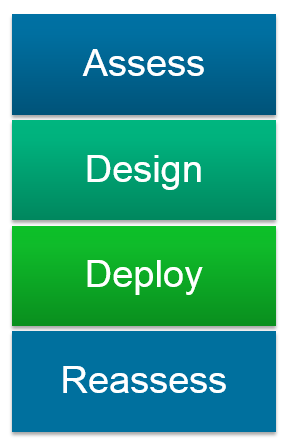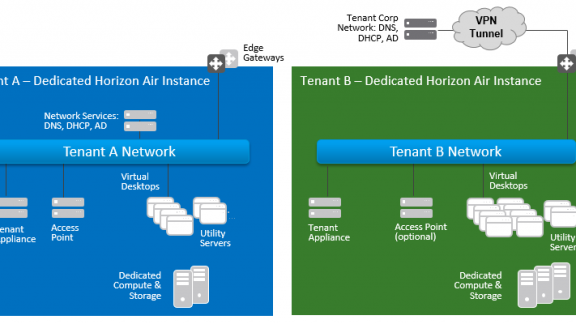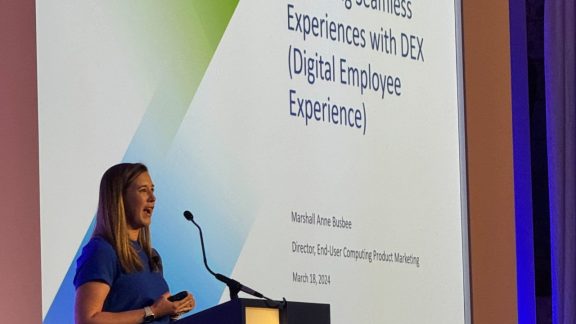By Daniel Berkowitz, Horizon Air Senior Solutions Engineer
Managing virtual desktops requires some infrastructure services to support everyday use, services such as: user authentication and entitlement (Active Directory), IP address management (DHCP), Key Management Services and File Services. This isn’t an exhaustive list; it is really any service that supports the desktop’s basic functionality so that a user can log on and access resources.
When moving to VMware Horizon Air these requirements don’t change; you still need to make sure these services are available for all your desktops. We make sure that you have options available to support your desktops, but you need to be aware of the considerations while planning for utility servers running in Horizon Air.

The idea behind a utility server is to provide resources for those services that support the everyday desktop workload (like I mentioned above, the services needed for users to log in and access resources). A utility server is not meant to run server-based workloads or transactional applications due to the potential adverse impact on the performance of the desktop.
The workload considerations in Horizon Air are the same for running desktops on Horizon View. You want to avoid combining servers and desktops on the same resources. As you would expect, VMware’s best practices for workload placement are also used in Horizon Air. When you subscribe to Horizon Air, you determine the scope, the size of your desktops and how many of each you need. Your environment is deployed on dedicated compute (with HA), dedicated storage volumes and a dedicated management interface.
The Horizon Air service provides one virtual machine (VM) as an optional utility server with the same resources as an Advanced Desktop, providing two virtual CPUs (vCPUs), 4 GB of virtual RAM (vRAM) and a 60 GB hard drive.
Utility Server Options for Active Directories

Active Directory is a requirement in most environments today, including in Horizon Air. If you look at Tenant B above (green box), this Tenant has a VPN tunnel to their data center providing Active Directory, DNS and DHCP. This is fully supported and works very well.
You also have the option of extending your Directory services into Horizon Air. Extending Active Directory, such as a read-only domain controller, would provide redundancy in case of a disconnect between your corporate data center and your desktops.
If you are beginning a proof of concept and would rather not extend directory services, look at Tenant A (blue box). You can also configure Horizon Air as an island and use the utility server to create a separate Active Directory instance for the proof of concept.
Other uses for utility servers are User Environment Manager (UEM) configuration and Profile shares, File server or DHCP relay. Microsoft System Center Configuration Manager (SCCM), and anti-virus servers are allowed in limited quantities to protect the integrity of the service.
[Read also: VMware User Environment Manager: Taking Horizon Air to the Next Level!]
Adding Utility Servers and Compute or Storage Space

If you need additional utility servers, or storage for an existing utility server, you can allocate more by using the desktops that are available in your subscription. Each additional utility server will decrease your desktop count by one. For example, if you’ve purchased 100 Advanced desktops and need an additional utility server, take one out of your pool, request that it be used as a utility server, and we can make the appropriate change. You would then have 99 Advanced desktops remaining for your users and two utility servers, the original provided and the one you’ve just created. To combine the compute resources for a utility server, you can reallocate the resources from two Advanced desktops and create a utility server with four vCPUs, 8 GB of vRAM and 120 GB of disk. This would provide a utility server with the same resources as our Enterprise desktop compute.
If you need additional resources such as compute or storage space, there are options available. These include purchasing additional Enterprise desktops or the very large Enterprise Plus desktop each with the resources listed in the diagram above. If the Advanced desktop has enough compute but you need storage, you can purchase 1 TB of storage as an add-on. Additionally, with the storage add-on you have the flexibility to allocate the storage across utility servers and desktops however you prefer.
 You have a lot of options with compute and storage for your utility server needs in Horizon Air, and we want to be sure that you have the resources available to provide your users with an optimal experience. Although you’ll need to keep in mind that just because you can, it doesn’t mean you should. Best practices are guidelines to help you optimize your solution and help navigate pitfalls. Try to follow VDI best practice for what and where you place utility servers in your environment.
You have a lot of options with compute and storage for your utility server needs in Horizon Air, and we want to be sure that you have the resources available to provide your users with an optimal experience. Although you’ll need to keep in mind that just because you can, it doesn’t mean you should. Best practices are guidelines to help you optimize your solution and help navigate pitfalls. Try to follow VDI best practice for what and where you place utility servers in your environment.
Utility servers require additional considerations for scale and performance. Keep in mind that VMware reserves the right to require you to upgrade the server specification or ultimately remove the VM if there is an adverse impact on the performance of desktop VMs.
As you continue to see success with Horizon Air and additional desktops are added, you may need more utility servers, but how does adding more utility servers effect performance? While you could add two utility servers for anti-virus or two web content filters, the question to ask is what will those workloads do to your user experience?
That’s an unknown until you do an assessment of the desktops and current user experience. Until then, the recommendation is to fall back to best practice and try not to mix workloads. Rather than impact user performance, it may be a good time to look at Infrastructure as a Service (IaaS) options and move the utility servers out of Horizon Air.
[Read also: VMware Expands Partnership with IBM & Offers VMware Horizon Air on IBM Cloud]
To read more about the Horizon Air service, see the Service Description PDF and the Horizon Air Cloud-Hosted Desktops and Apps FAQs .







